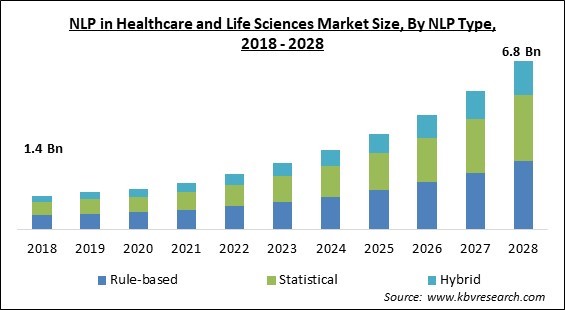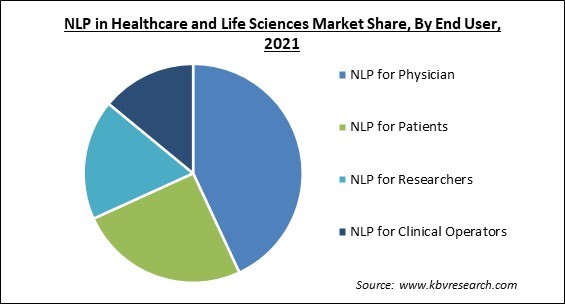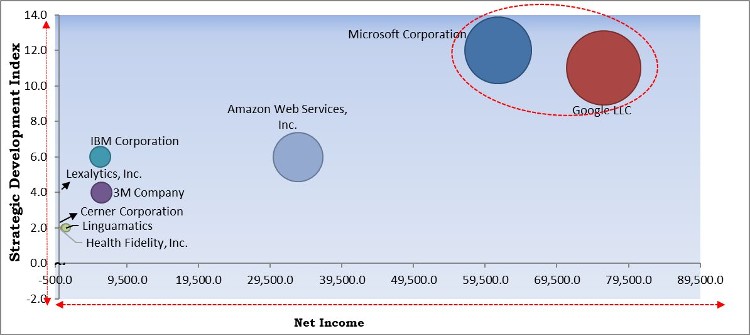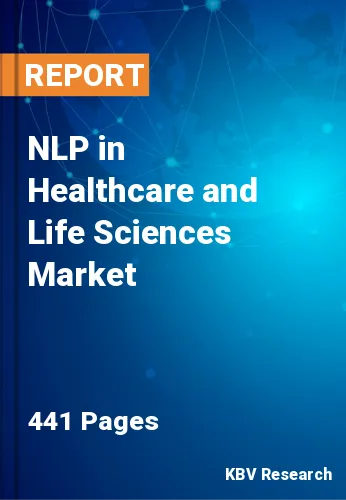The Global NLP in Healthcare and Life Sciences Market size is expected to reach $6.8 billion by 2028, rising at a market growth of 20.3% CAGR during the forecast period.
Natural Language Processing (NLP) refers to a computer program's ability to comprehend and present data in the form of current human language, speech phrases, and text. In the healthcare industry, NLP is employed in a variety of ways, including improving the quality of care and raising outcomes, as well as automating virtual patient conversational activities. Email filtration, predictive messaging, smart assistance, digital phone calls, and language translations are all examples of where NLP is applied.
Doctors may spend as long as necessary with their patients and give them their undivided attention due to the NLP platform. A number of clinicians prefer printed or typed voice notes. As a result, the NLP platform may be utilized to accurately analyze speech and update data. Unstructured data in real-world data sources like EHRs, patient forums, and other sources make extracting usable insights from the data challenging and time-consuming. This issue is alleviated by AI-powered NLP technology. Pharma companies are using natural language processing (NLP) in drug discovery, text mining EHR data, and utilizing data to produce future insights for commercial advantages, resulting in actionable insights that improve care and efficacy. Furthermore, NLP has a wide range of applications in the pharmaceutical industry, including drug development, clinical trials, regulatory insights, market insights, real-world data, pharmacovigilance, and more.
Natural language processing for life sciences and healthcare sciences is a combination of artificial intelligence, computer science, and computational linguistics that allows computers to understand human speech as it is spoken. Clinicians and researchers can use it to produce, preserve, and utilize a variety of semi-structured and unstructured textual documents. In healthcare and life sciences, high-end NLP technologies for information extraction, automatic voice recognition, machine translation, and dialogue systems are used. NLP is an umbrella term for the process of employing computer algorithms to detect primary components of ordinary language and extract meaning from unstructured spoken or written material. Some NLP efforts aim to pass the Turing test by creating algorithmically-based creatures that can respond to conversations or searches in a human-like manner. Others employ voice recognition technology to try to interpret human speech, such as automated customer service programs.

The COVID-19 pandemic is causing havoc in the world. It has inflicted whole economies & businesses and affected the career and personal lives of individuals. As businesses turn their focus away from development prospects and toward implementing extraordinary measures to limit the negative impact of the COVID-19 pandemic, the stress to maintain the revenue levels at pre-COVID levels has become the new normal. Pharmaceutical and healthcare organizations, governments, and the larger scientific community are all attempting to assess the virus's impact and provide speedy, accurate treatments in the ongoing fight against COVID-19. NLP technology, according to a few suppliers in the industry, will enable fast, systematic, and comprehensive insight production from unstructured text.
The need for improved utilization of unstructured data is being driven by a shift in business models and outcome expectations. Traditional health information systems have concentrated on extracting value from the relatively small quantities of structured healthcare data received through clinical channels. However, NLP can extract patient information from unstructured, free-form language and generate actionable data that can be utilized to improve patient care and expedite workflow. NLP systems that are well-designed can assess text-free dictation, recognize situations, and tag the most important clinical data items such as problems, social history, drugs, allergies, and treatments.
Some well-known businesses in the market have made considerable investments in semantic big data analytics and cognitive computing technologies in the healthcare and life sciences industry. NLP offers a wide range of applications in healthcare, from cutting-edge precision medicine applications to the simple task of coding a claim for reimbursement or billing. However, developing algorithms that are smart, accurate, and specific to ground-level concerns in the healthcare and life sciences industries will be critical to the success of deploying this technology. In order for patients to have an accurate record of their health in a language they can comprehend, NLP will have to achieve the dual aims of data abstraction and data presentation. Within the healthcare industry, this enhanced approach would improve physical efficiency while lowering operating expenses.
NLP is a technique for processing sequential data such as text, speech, financial data, time series, audio, and video that employs neural networks and deep learning algorithms. The most sophisticated technologies that are laying the groundwork for NLP to acquire momentum in the market are neural networks and deep learning. However, developing these technologies is extremely costly and necessitates a significant investment in both R&D funds and time, which is difficult for small or startup enterprises looking to enter the NLP market in healthcare and life sciences.

Based on Component, the market is segmented into Solution and Services. Based on Solution Type, the market is segmented into Clinical Variation Management, Population Health Management, Counter Fraud Management, and Others. The services segment observed a substantial revenue share of the NLP in healthcare and life sciences market in 2021. Professional services and managed services fall in the services section. These services are critical to the operation of NLP in the healthcare and life sciences industries, as well as ensuring a faster and smoother implementation that maximizes the value of the company's investments. Professional and managed services are projected to rise in popularity as NLP technology becomes more widely adopted. Professional service providers provide in-depth product knowledge, allowing clients to focus on their primary business, whereas MSPs assist healthcare organizations in improving their business processes and lowering total costs.
Based on End User, the market is segmented into NLP for Physician, NLP for Patients, NLP for Researchers, and NLP for Clinical Operators. The NLP for physicians segment acquired the largest revenue share in the NLP in healthcare and life sciences market in 2021. Physicians and electronic health records don't always get along. Additional data input tasks present difficulties and might be aggravating. According to certain studies, some physicians are suffering from EHR burnout and are threatening to retire early rather than deal with the numerous clicks and screens required to manage their EHR. Since NLP healthcare solutions can quickly access and effectively interpret clinical material, medical NLP is rapidly showing to be a solution to this problem. The benefits of healthcare technology will be widely lauded and consumers will face less of the daily hassles once the friction of the technology is lessened.
Based on NLP Type, the market is segmented into Rule-based, Statistical, and Hybrid. The statistical segment observed a significant revenue share of the NLP in healthcare and life sciences market in 2021. Due to the growing demand for translating EHRs and giving appropriate results in structured data form, the statistical NLP industry is expected to gain pace in the next years. Statistical NLP-based solutions are used in the healthcare and life sciences industries to respond faster to changing business needs. After extracting the repository of unstructured clinical data, this kind of NLP allows medical researchers and practitioners to examine trends and patterns in order to look for statistically important conclusions. This method is commonly used in applications like eCRM, sentiment analysis, and information extraction.
Based on Deployment Mode, the market is segmented into Cloud and On-premise. The cloud segment acquired the largest revenue share of the NLP in healthcare and life sciences market in 2021. This is due to the increasing availability of easy deployment alternatives and minimal capital and time requirements. Cloud-based systems allow several healthcare workers to share clinical data through the Internet. Due to the obvious numerous benefits of cloud-based NLP systems, such as optimization, cost-effectiveness, user-friendliness, and expedited access to crucial patient data, healthcare organizations are rapidly adopting these solutions.
Based on Organization Size, the market is segmented into Large Enterprises and Small & Medium Enterprises (SMEs). The SMEs segment obtained a significant revenue share of the NLP in healthcare and life sciences market in 2021. This is the case since cloud-based solutions and services assist SMEs to improve business performance and efficiency. Due to NLP services being deployable on the cloud, the investment required to implement NLP has fallen drastically. This has been encouraging news for the SMEs segment as these organizations operate on a relatively tight budget.
Based on Application, the market is segmented into IVR, Summarization & Categorization, Reporting & Visualization, Pattern & Image Recognition, Text & Speech Analytics, Predictive Risk Analytics, and Others. The IVR segment acquired the largest revenue share of the NLP in healthcare and life sciences market in 2021. IVR is a useful telehealth tool that expands healthcare coverage by allowing patients to get care outside of the hospital setting. IVR is curated with particularly developed programs that are easily accessible to patients 24 hours a day, resulting in better adoption in the healthcare and life sciences business.
| Report Attribute | Details |
|---|---|
| Market size value in 2021 | USD 1.9 Billion |
| Market size forecast in 2028 | USD 6.8 Billion |
| Base Year | 2021 |
| Historical Period | 2018 to 2020 |
| Forecast Period | 2022 to 2028 |
| Revenue Growth Rate | CAGR of 20.3% from 2022 to 2028 |
| Number of Pages | 441 |
| Number of Tables | 743 |
| Report coverage | Market Trends, Revenue Estimation and Forecast, Segmentation Analysis, Regional and Country Breakdown, Competitive Landscape, Companies Strategic Developments, Company Profiling |
| Segments covered | Component, End User, NLP Type, Deployment Mode, Organization Size, Application, Region |
| Country scope | US, Canada, Mexico, Germany, UK, France, Russia, Spain, Italy, China, Japan, India, South Korea, Singapore, Malaysia, Brazil, Argentina, UAE, Saudi Arabia, South Africa, Nigeria |
| Growth Drivers |
|
| Restraints |
|
Based on Regions, the market is segmented into North America, Europe, Asia Pacific, and Latin America, Middle East & Africa. North America acquired the largest revenue share of the NLP in healthcare and life sciences market in 2021. The success of main suppliers in the market in North America is due to the early implementation of NLP solutions and significant improvements in IT infrastructure across healthcare sectors. Because of the favorable approach of government laws, startup funding, established player presence, and enthusiasm from enterprises to deploy ML and NLP-based solutions, the region has seen excellent conditions for the expansion of NLP in the healthcare and life sciences market. There is also plenty of research being conducted in American universities to analyze the benefits of the widespread deployment of NLP in healthcare and life sciences.
Free Valuable Insights: Global NLP in Healthcare and Life Sciences Market size to reach USD 6.8 Billion by 2028

The major strategies followed by the market participants are Partnerships. Based on the Analysis presented in the Cardinal matrix; Microsoft Corporation, Google LLC are the forerunners in the NLP in Healthcare and Life Sciences Market. Companies such as Lexalytics, Inc., IBM Corporation and Amazon Web Services, Inc. are some of the key innovators in the Market.
The market research report covers the analysis of key stake holders of the market. Key companies profiled in the report include 3M Company, IBM Corporation, Microsoft Corporation, Google LLC, Amazon Web Services, Inc., Cerner Corporation, Corti ApS, Lexalytics, Inc., Health Fidelity, Inc., and Linguamatics.
By Component
By End User
By NLP Type
By Deployment Mode
By Organization Size
By Application
By Geography
The global NLP in healthcare and life sciences market size is expected to reach $6.8 billion by 2028.
Development of Cognitive Computing are increasing are driving the market in coming years, however, high cost of R&D in NLP growth of the market.
3M Company, IBM Corporation, Microsoft Corporation, Google LLC, Amazon Web Services, Inc., Cerner Corporation, Corti ApS, Lexalytics, Inc., Health Fidelity, Inc., and Linguamatics.
NLP technology is required for accurate treatments in the ongoing fight against COVID-19. As it enable fast, systematic, and comprehensive insight production from unstructured text.
The Solution segment acquired the maximum revenue share in the Global NLP in Healthcare and Life Sciences Market by Component in 2021; thereby, achieving a market value of $4.4 billion by 2028.
The North America is the fastest growing region in the Global NLP in Healthcare and Life Sciences Market by Region in 2021, and would continue to be a dominant market till 2028.
Our team of dedicated experts can provide you with attractive expansion opportunities for your business.

